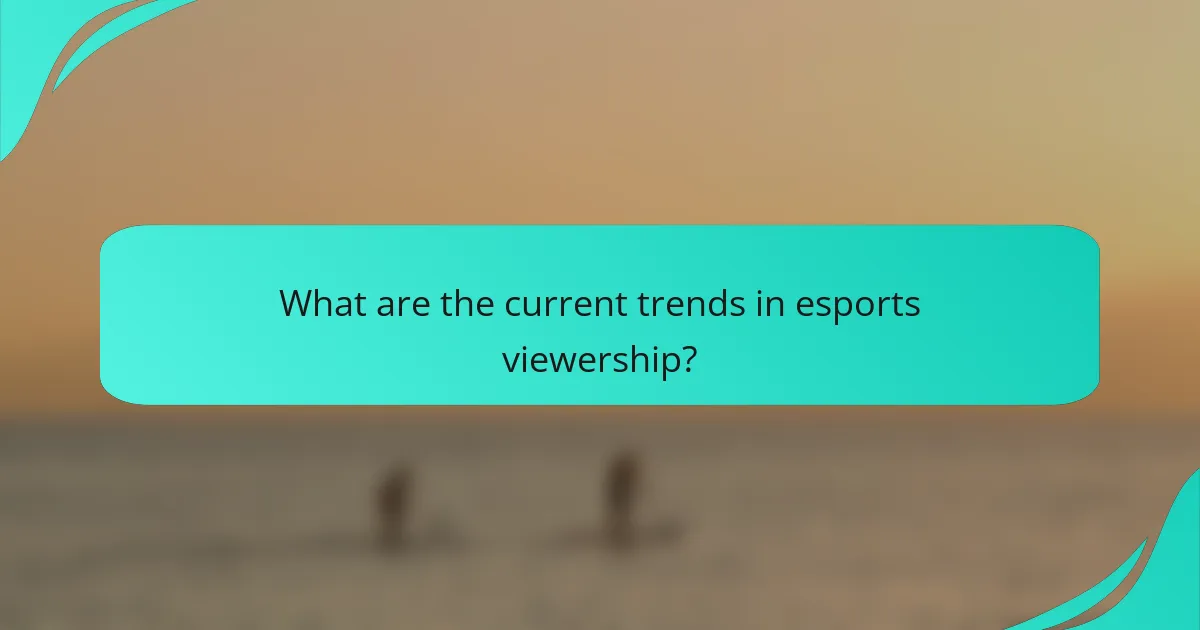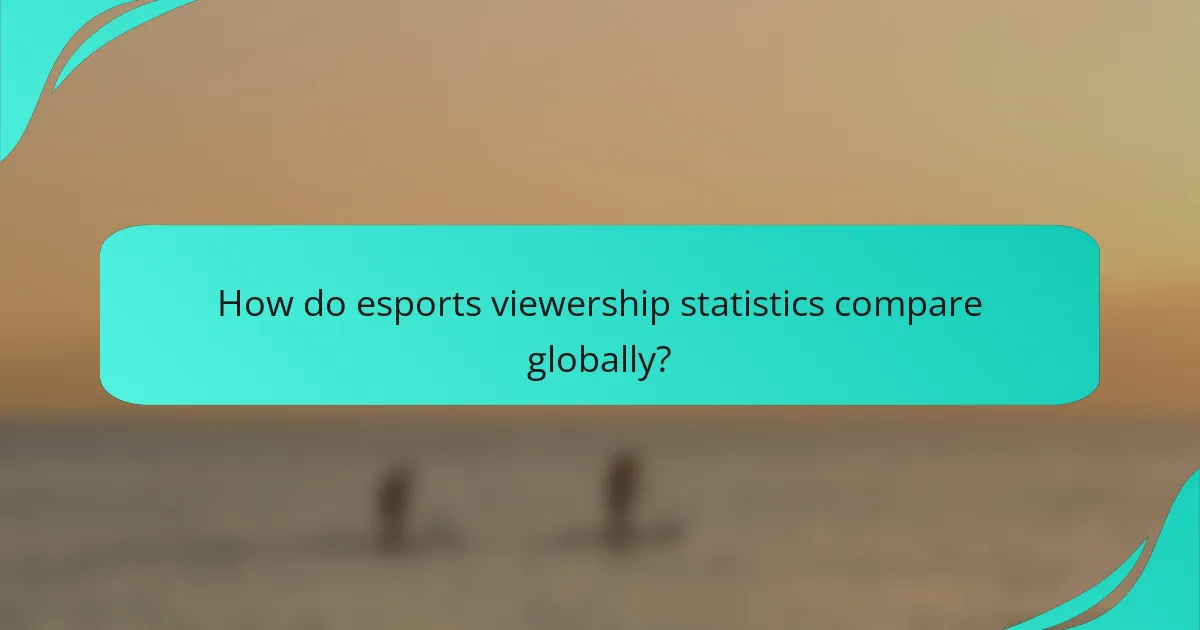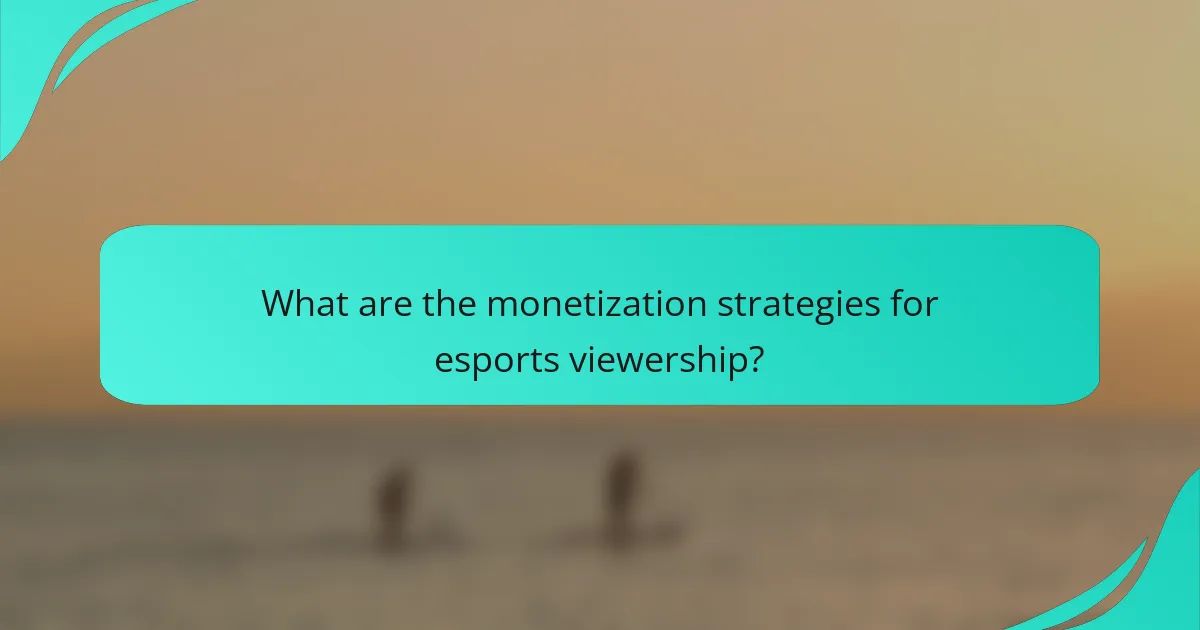The esports industry is experiencing a remarkable surge in viewership, particularly through mobile platforms and streaming services, reflecting a growing audience engagement. Projections suggest that by 2025, the number of esports viewers could reach approximately 600 million, driven by enhanced accessibility and technological advancements. Analyzing the demographics, game popularity, and streaming platforms is essential for stakeholders aiming to effectively engage this expanding audience.

What are the current trends in esports viewership?
Current trends in esports viewership highlight a significant increase in audience engagement, particularly through mobile platforms and streaming services. As esports continues to grow, understanding these trends can help stakeholders capitalize on emerging opportunities.
Increased mobile viewership
Mobile viewership in esports has surged, driven by the accessibility of games on smartphones and tablets. This trend allows fans to watch tournaments and streams from anywhere, contributing to a broader audience base.
Many popular games, such as PUBG Mobile and Call of Duty: Mobile, have optimized their experiences for mobile users, attracting millions of players and viewers. Brands looking to engage with this demographic should consider mobile-friendly content and advertising strategies.
Growth of streaming platforms like Twitch
Streaming platforms, particularly Twitch, have become central to esports viewership, providing a space for live broadcasts and community interaction. Twitch alone boasts millions of daily active users, with a significant portion tuning in for esports events.
Content creators and professional gamers often use these platforms to build their brands, leading to increased sponsorship and advertising revenue. Engaging with audiences through interactive features like chat and polls can enhance viewer retention and loyalty.
Rise of esports events in major cities
Esports events are increasingly hosted in major cities worldwide, attracting large crowds and boosting local economies. These events often feature live audiences, which enhances the overall experience for fans and participants alike.
Cities like Los Angeles, London, and Seoul have become hotspots for esports tournaments, offering opportunities for local businesses to engage with the gaming community. Organizers should consider partnerships with local venues and sponsors to maximize the impact of these events.

How is esports viewership predicted to grow?
Esports viewership is expected to see significant growth in the coming years, with projections indicating a rise to around 600 million viewers by 2025. This increase is driven by factors such as greater accessibility, improved streaming technology, and heightened interest from both fans and investors.
Projected audience growth to 600 million by 2025
The esports audience is forecasted to grow substantially, reaching approximately 600 million viewers by 2025. This growth is attributed to the increasing popularity of competitive gaming and the expansion of streaming platforms that make esports more accessible to a global audience.
Key demographics driving this growth include younger generations who are more inclined to engage with digital content. As more people become aware of esports events through social media and streaming services, the viewer base is likely to expand significantly.
Increased investment from brands and sponsors
Investment from brands and sponsors is a crucial factor in the growth of esports viewership. Companies are recognizing the potential of esports as a marketing platform, leading to increased sponsorship deals and advertising revenue. This influx of capital not only supports events but also enhances production quality, making broadcasts more appealing to viewers.
Brands are increasingly targeting the esports audience, which is often younger and more engaged than traditional sports fans. This has resulted in partnerships that leverage influencer marketing and interactive campaigns, further driving viewer interest and participation in esports events.

What factors influence esports viewership?
Esports viewership is influenced by several key factors, including audience demographics, game popularity, and the platforms used for streaming. Understanding these elements can help stakeholders optimize their strategies for engaging viewers and maximizing reach.
Demographics of the audience
The demographics of esports audiences vary significantly, with a strong presence among younger viewers, particularly those aged 18 to 34. This age group tends to be tech-savvy and engages with content primarily through digital platforms.
Gender representation is also evolving, with an increasing number of female viewers participating in esports. As the audience diversifies, content creators and sponsors are adapting their approaches to cater to a broader range of interests and preferences.
Popularity of specific games like League of Legends
Specific games, such as League of Legends, play a crucial role in driving esports viewership. The game’s competitive nature and regular updates keep players engaged, contributing to a loyal fan base that regularly tunes in for tournaments and events.
Other popular titles, like Dota 2 and Counter-Strike: Global Offensive, also attract significant viewership, but League of Legends consistently ranks among the top due to its established esports ecosystem and high-stakes competitions. The success of these games often hinges on community engagement and the quality of the competitive scene.

How do esports viewership statistics compare globally?
Esports viewership statistics reveal significant differences across regions, influenced by cultural preferences, internet accessibility, and gaming popularity. Globally, millions engage with esports content, but the distribution of viewers varies widely, with North America and Europe leading in numbers, while Asia shows rapid growth in emerging markets.
North America vs Europe viewership rates
In North America, esports viewership is robust, with millions tuning in for major tournaments and leagues. Popular games like League of Legends and Fortnite attract large audiences, often reaching peak viewership in the low millions during key events.
Europe, on the other hand, boasts a diverse gaming culture, with countries like Germany and the UK showing particularly high engagement. Viewership rates can rival those in North America, especially for games like Counter-Strike: Global Offensive and Dota 2, where audiences frequently exceed several hundred thousand during live streams.
Emerging markets in Asia
Asia is witnessing explosive growth in esports viewership, particularly in countries like China and South Korea. The rise of mobile gaming and platforms like Douyin and Bilibili has contributed to this surge, with viewership numbers often reaching tens of millions for popular tournaments.
In addition to established markets, regions such as Southeast Asia are rapidly adopting esports, driven by increased internet access and a young, tech-savvy population. This trend indicates a promising future for esports, with potential for significant audience expansion in the coming years.

What are the challenges facing esports viewership?
Esports viewership faces several challenges that can hinder its growth and engagement. Key issues include content saturation on streaming platforms and varying regulatory environments across different regions.
Content saturation on streaming platforms
Content saturation occurs when there is an overwhelming amount of esports content available, making it difficult for viewers to find and engage with their preferred streams. With numerous tournaments, leagues, and individual streamers competing for attention, audiences may feel overwhelmed and less inclined to commit time to specific events.
To combat saturation, platforms can curate content more effectively, highlighting trending games or popular streamers. Viewers should consider following niche channels or specific tournaments that align with their interests to avoid the noise of mainstream offerings.
Regulatory issues in different regions
Regulatory challenges can significantly impact esports viewership, as different countries have varying laws regarding online gaming, gambling, and broadcasting rights. For instance, some regions may impose restrictions on sponsorships or advertising, limiting how events can be promoted and monetized.
Esports organizations must navigate these regulations carefully to ensure compliance while maximizing their reach. Viewers should be aware that the availability of certain tournaments or streams may vary based on their location due to these legal constraints.

What are the monetization strategies for esports viewership?
Monetization strategies for esports viewership primarily include advertising revenue, sponsorship deals, and merchandise sales. These methods leverage the growing audience and engagement levels in esports to generate significant income for teams, players, and platforms.
Advertising revenue from platforms like YouTube
Advertising revenue is a crucial monetization strategy for esports, especially through platforms like YouTube, where content creators can earn money from ad placements. These ads can be displayed before, during, or after streams, with revenue typically based on views and clicks.
On YouTube, esports channels can generate revenue ranging from a few hundred to several thousand dollars per month, depending on their viewership numbers. Creators should focus on producing high-quality, engaging content to maximize their ad revenue potential.
Sponsorship deals with major brands
Sponsorship deals are another significant revenue source for esports organizations, where brands partner with teams or events to promote their products. These deals can vary widely in value, often ranging from thousands to millions of dollars, depending on the brand’s reach and the team’s popularity.
Successful sponsorships typically involve brand integration into team merchandise, event promotions, and social media campaigns. Teams should seek partnerships that align with their audience’s interests to enhance engagement and ensure mutual benefits.

How do esports events impact local economies?
Esports events significantly boost local economies by attracting tourism, creating jobs, and generating revenue for various sectors. These events can lead to increased spending in hospitality, transportation, and retail, benefiting the community as a whole.
Job creation and employment opportunities
Esports events create numerous job opportunities, both temporary and permanent. Positions range from event management and marketing roles to technical support and hospitality services. Local businesses often hire additional staff to accommodate the influx of visitors during major tournaments.
Increased tourism and local spending
Hosting esports tournaments attracts fans from various regions, leading to increased tourism. Visitors typically spend money on accommodations, food, and entertainment, which stimulates the local economy. For example, a large event can see thousands of attendees, resulting in significant revenue for hotels and restaurants.
Infrastructure development
Esports events can prompt improvements in local infrastructure, such as transportation and venue facilities. Cities may invest in better public transport options or upgrade existing venues to accommodate larger crowds. This development not only benefits the event but also enhances the overall quality of life for residents.
Long-term economic benefits
While the immediate impact of esports events is often visible, the long-term benefits can be substantial. Successful events can establish a city as a hub for esports, attracting future tournaments and fostering a local gaming community. This ongoing engagement can lead to sustained economic growth and innovation in related industries.
